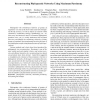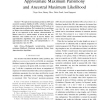77 search results - page 1 / 16 » Reconstructing Phylogenetic Networks Using Maximum Parsimony |
CSB
2005
IEEE
13 years 10 months ago
2005
IEEE
Phylogenies—the evolutionary histories of groups of organisms—are one of the most widely used tools throughout the life sciences, as well as objects of research within systema...
TCBB
2010
13 years 2 months ago
2010
— We explore the maximum parsimony (MP) and ancestral maximum likelihood (AML) criteria in phylogenetic tree reconstruction. Both problems are NP hard, so we seek approximate sol...
TCBB
2008
13 years 4 months ago
2008
Reconstruction of phylogenetic trees is a fundamental problem in computational biology. While excellent heuristic methods are available for many variants of this problem, new adva...
BMCBI
2007
13 years 4 months ago
2007
Background: Maximum parsimony phylogenetic tree reconstruction from genetic variation data is a fundamental problem in computational genetics with many practical applications in p...
TCBB
2008
13 years 4 months ago
2008
Abstract-- The Maximum Parsimony problem aims at reconstructing a phylogenetic tree from DNA sequences while minimizing the number of genetic transformations. To solve this NP-comp...


